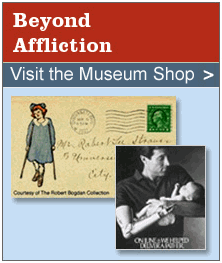Education: Lesson Details
Study Guide: Activities and Procedures
Section 1 - READING
Have students individually read the “Letter from Mason Cogswell to John Braidwood, April 20, 1812,” and respond in their journal to the following questions: What do you think life was like for a deaf person in America in the year 1812 based on the letter written by Cogswell? How might individuals with hearing disabilities respond to Cogswell’s statements if he were to publish the same letter in the present day?
Have the students get together in random groups of two. Ask the pair to discuss their journal responses to the questions posed about Cogswell’s letter. They should compare and contrast their ideas with regard to each question. Ask one student to act as the spokesperson for the group.
The teacher should lead a discussion where each group shares their main ideas from the journaling exercise with the entire class in a large group discussion format. The teacher should record the main themes on the board or overhead during the discussion. Questions to guide the discussion: What was Cogswell’s purpose in writing the letter to Braidwood? How does Cogswell use persuasive language to make his requests? Examples? How would Cogswell’s description of his daughter as belonging to a “class of unfortunate beings” be received in modern society? What can you infer about the relative educational and vocational opportunities available to deaf people in the early 19th century?
Annotated & Abridged Document:
Mason Cogswell To John Braidwood, April 20, 1812
1.) What role does parenting play in this early step in the process that would lead to the creation of the American School for the Deaf?
2.) What does Cogswell want from Braidwood?
3.) How does Cogswell describe the establishment of an institution for deaf education? How does he refer to deafness?
Section 2 - SMALL GROUP ACTIVITY
Have the pairs of students from the first part of the lesson cluster together in small groups of four. Each student will read a copy of the contract between Clerc and Gallaudet paying particular attention to article 11 and Gallaudet's sermon. Each of the four students will then take on the responsibility of carrying out an information quest related to one of the following topics and later report back to the group: 1.) Biographical information on Mason Cogswell; 2.) Biographical information on Laurent Clerc; 3.) Biographical information on Thomas Gallaudet; 4.) Information on Protestantism and the Second Great Awakening in the early 19th century.
The students may use reference materials in the Disability History Museum, the Internet, the library, textbooks, etc. to locate this information. Following the information quest, the team of students will briefly report on their findings to the rest of the group.
Background Essay: Asylum for the Deaf and Dumb
Background Essay: Monsieur Laurent Clerc
Background Essay: Rev. Thomas Gallaudet
Background Essay: Religion In Nineteenth-Century America
Annotated & Abridged Document:
Contract Between Thomas Gallaudet And Laurent Clerc
Annotated & Abridged Document:
Sermon, On The Duties And Advantages Of Affording Instruction To The Deaf And Dumb
Annotated & Abridged Document:
Report Of The Committee Of The Connecticut Asylum For The Education And Instruction Of Deaf And Dumb Persons
Annotated & Abridged Document:
Eighth Report Of The Directors Of The American Asylum, At Hartford, For The Education And Instruction Of The Deaf And Dumb, Exhibited To The Asylum, May 15, 1824
Section 3 - DISCUSSION
The teacher will then lead an interactive lecture discussion on the key concepts related to the lesson using the following prompt questions:
1.) Who were Clerc, Cogswell and Gallaudet?
2.) What were their respective roles in the history of deaf education?
3.) What motivated each of these individuals to work with the deaf population?
4.) What purpose did the contract serve?
5.) What language in the contract suggests how life might have been different in 1816 versus the present day?
6.) How were individuals with hearing disabilities referred to throughout the contract?
7.) What does article 11 and Gallaudet's Sermon suggest about the religious beliefs of Clerc and Gallaudet?
8.) What does article 11 and Gallaudet's Sermon suggest about the prominence of religion in education in the early 1800s?
9.) What was the prevailing religious movement in the United States in the early 19th century? What were the primary goals of this religious movement? How did these goals relate to deaf education in terms of Gallaudet’s efforts?
10.) What other groups might have been considered “heathens” at that time? Why do you think so?
11.) Why do you think Gallaudet was willing to accommodate Clerc’s divergent religious beliefs in order to bring him to Hartford in 1816?
Section 4 - WRITING ASSIGNMENT
Students would work individually or in teams to complete one of the following application projects:
Write a letter to the editor of an 1816 newspaper stressing the importance of religious tolerance.
Write an essay comparing and contrasting the use of language to describe deaf individuals in 1816 versus the present day.
Write a poem from the perspective of a deaf person living in 1816.
Write an essay about international travel in the early nineteenth century based on Clerc’s diary of his trip from France.
Write a letter to the editor of a newspaper on the importance of bringing religion to deaf people.
Bibliography
Baynton, Douglas C. , Forbidden Signs: American Culture and the Campaign against Sign Language (Chicago: The University of Chicago Press, 1996).
Edwards, R.A.R. , “‘Speech Has an Extraordinary Humanizing Power’: Horace Mann and the Problem of Nineteenth-Century American Deaf Education,” in Paul K. Longmore and Lauri Umansky, eds., The New Disability History: American Perspectives (New York: New York University Press, 2001), pp.58-82.
Van Cleve, John Vickrey, and Barry A. Crouch, A Place of Their Own: Creating the Deaf Community in America (Washington, D.C.: Gallaudet University Press, 1989).






